| |
Shrine No. 5 |
last update:
06.02.2007
|
Data
| Shrine No. |
Name /
Transliteration |
Date |
Distance to the Speos of Haremhab
[~ m] |
Remarks |
| 5 |
Min (Menu) |
Thutmosis III |
237 |
|
| |
|
|
|
|
| All data according to Caminos, 1963 |
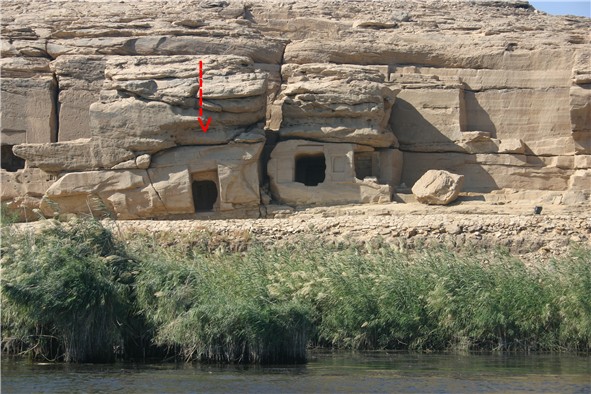
|
From right to left and side by side the shrines No.: 3, 4 (Djehutimose) and 5
(Menu; see red arrow). Shrine 4 is dated to the end of the 18th Dynasty or
shortly after Thutmosis III, shrine 5 is dated into the reign Thutmosis III. Today
the shrines are
a few meters away from the river bank. (photo: E. Noppes) |
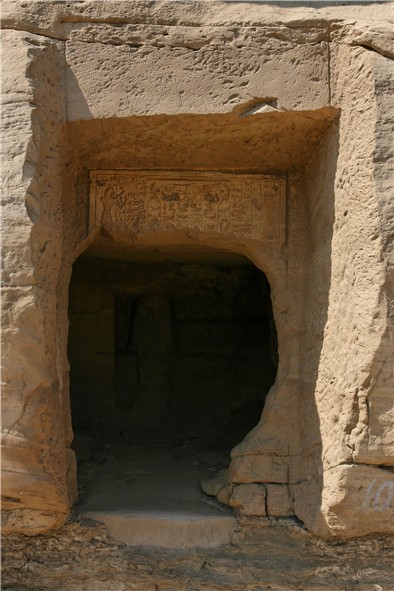
|
The photo above shows the actual condition of the entrance to shrine 5. The
shrine lies only a few meters above the today's water level. However, the part
of the rock which contains the shrine has detached itself from the main mass and
slipped down about 1.5 m (at the same time shrine 4 has been split and its
southern room slipped down together with shrine 5). |
|
The doorway was cut back into the rock to a depth of about 1 m. The original
width was most likely 78 cm, but the left jamb is completely lost and only parts
of the right jamb have survived. The are no traces of a decoration to be seen on
the remaining parts of the jamb as well as on the rectangular area above the
doorway. However, the lintel has been carefully decorated. |
|
The interior consists of a single unfinished room with an irregular shape. The
width of the east side (side of the doorway) is about 1.9 m, the west side is
about 2.11, the length of the south wall is about 1.63 m, and the length of the
north wall is about 1.92 m. The average height of the room ist about 1.8 m. |
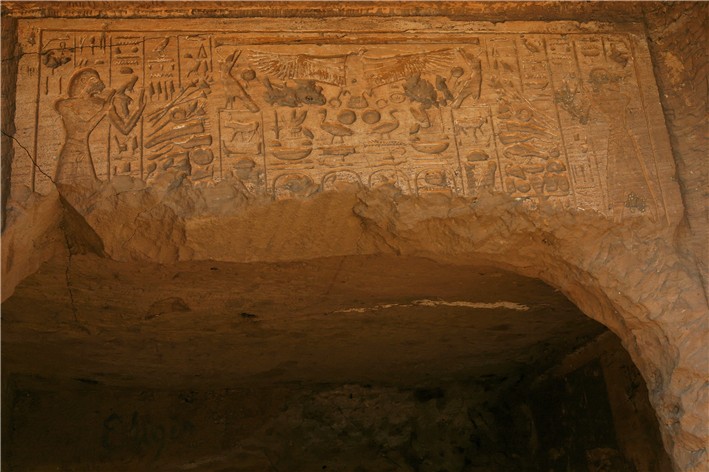
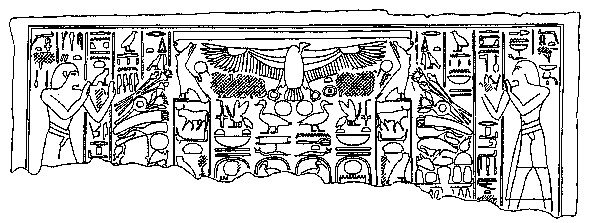
|
The lintel of the doorway had been white-plastered, the incised figures and
hieroglyphs had been painted in a fawn-brown color. The is divided in three
areas, the central part is covered by an elongated symbol of heaven. Below this
symbol the vulture goddess Nekhbet is shown, her name and epithet Nekhbet,
[the white one of] Nekheb which were placed under her wings had been defaced
in antiquity. The goddess hovers over the titulary of Thutmosis III which are
depicted twice one set facing north (right) the other one south. |
The titles on the north (right) side read:
"Horus, strong bull arising in
Thebes;
King of Upper and Lower Egypt, lord of the Two Lands; Men-kheper-Ra;
bodily son of Ra, Thutmosis, [beautiful-of-forms]" |
The area on the north side shows the owner of the shrine, Min, standing with
hands uplifted in a reverential gesture facing the titles of Thutmosis III. Min
is depicted standing before a table full of offerings. The accompanying
inscription reads (according to Caminos):
"Giving praise to the lord of the
Two Lands, kissing the ground before the good god by the hereditary prince and
count, friend great of love, excellent trusted one of his lord, overseer of
treasure, Min, possessing honor." |
The titles of Thutmosis are repeated on the south side so that they appear
symmetrically. However, there si a slight deviation:
"Horus, strong bull arising in
Thebes;
King of Upper and Lower Egypt, lord of the Two Lands; Men-kheper-Ra;
beloved son of Ra, Thutmosis, [beautiful-of-forms]" |
|
The inscription above Min reads: "Giving praise to the
sovereign, kissing the ground before him who arises in Thebes by the hereditary
prince [and count], sole friend, overseer of the treasure, Min, justified." |
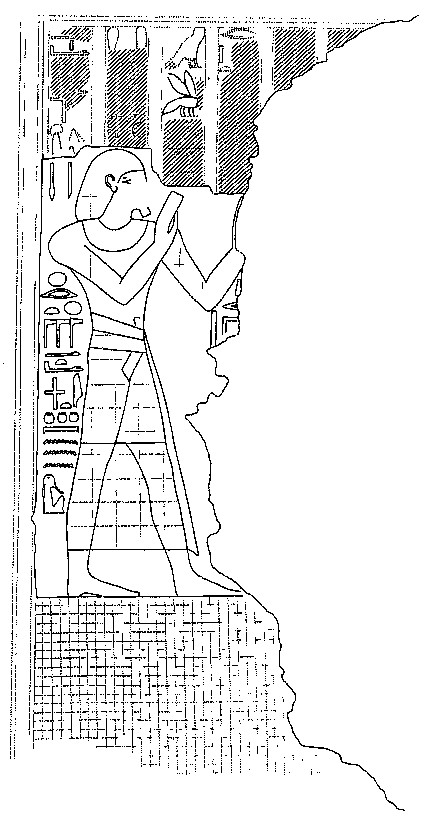
|
The east jamb of the doorway is completely lost. On the inside of the east wall
to the north of the doorway the scene shown above has survived. According to
Caminos the inscription above the scene has never been finished, the signs were
merely outlined in ink. Furthermore, the figure and the lower area of the wall
still show traces of a grid of squares drawn in red ink which was intended to
align the planned decoration. |
|
The remaining inscription accompanying Min reads: " ...sole [friend?], Min,
justified with the great Ennead that was in Nun". |
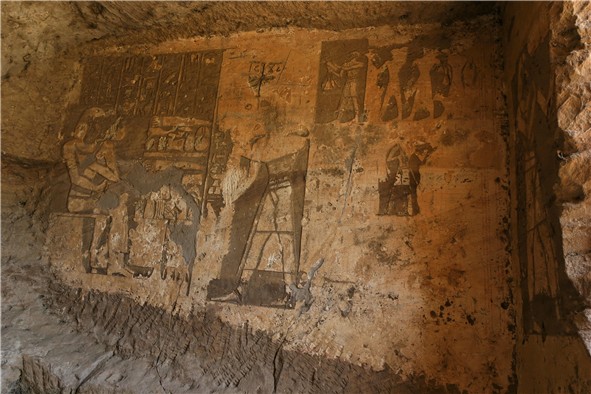
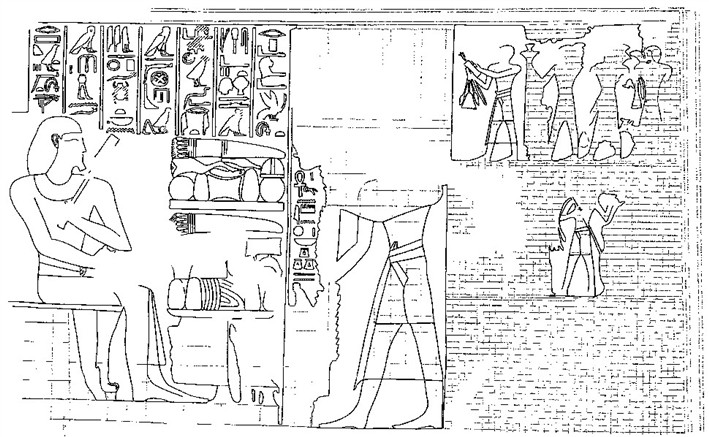
|
Also unfinished is the decoration of the north wall (see photo and drawing
above). In one large register on the west (left) side of the wall Min is
depicted sitting on a chair and facing towards the doorway. Before Min a table
full of offerings is shown. Min holds in his left hand a scepter and a piece of
cloth in his right. |
The inscription above identifies Min as the:
"hereditary prince and count,
treasurer of the king of Lower Egypt, sole friend, great chief in Upper Egypt,
judge in Lower Egypt; one who is sent and returns, his deed successfully
accomplished; one who has entrée to the council-chamber that he may bring joy,
the overseer of treasure, Min". |
|
On the other side of the offering-table, just in the center of the wall, a man
is depicted presenting a bouquet to Min. The figure has never been finished,
e.g. the head is completely missing. Furthermore, an inscription related to
figure is missing, thus it is not possible to identify the person. |
However, the source of the bouquet my be surmised on the basis of the few signs
in front of it:
"... a bouquet of Amun-Ra, lord of the Thrones of the Two
Lands, ..."
- Caminos assumes that the missing text would have pointed to the great
temple of Karnak. |
|
Behind the unknown man the eastern (right) part of the wall is occupied by three
register, one above the other, showing offering-bearers, most likely relatives
and retainers. Obviously, each register should contain four offering-bearers,
but they have nit been finished. Furthermore, any inscription accompanying
the offering-bearers is missing. |
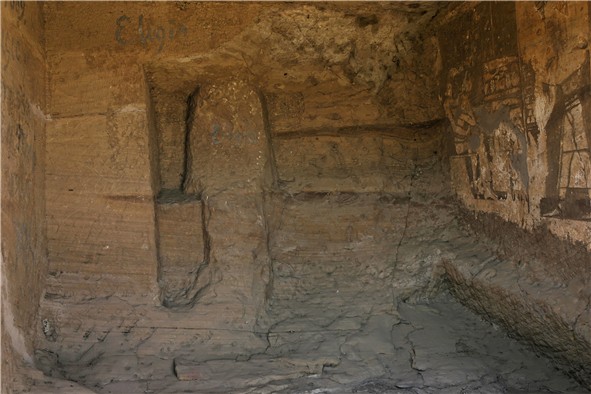
|
The west wall is occupied by an irregular shaped niche which earlier contained
two seated statues. The north-west corner, resp. wall, of the shrine is badly
destroyed but it is clear that this part was irregular hewn right at the outset. The
right one of the seated statues is completely destroyed, the left one was
probably never finished and was later damaged in addition. |
|
The south wall does not show any traces of a decoration. |
|







